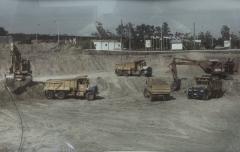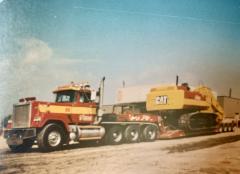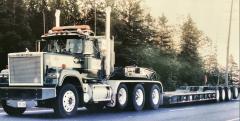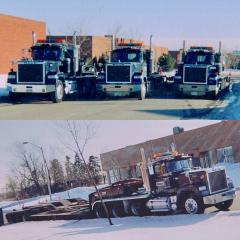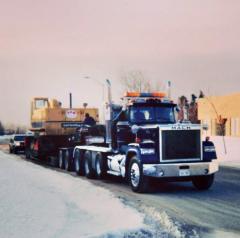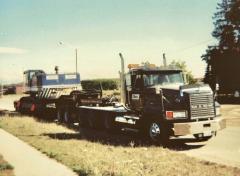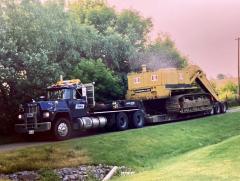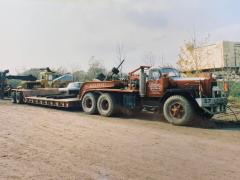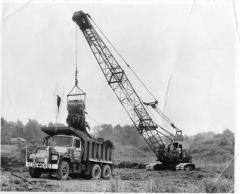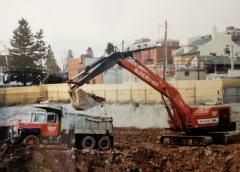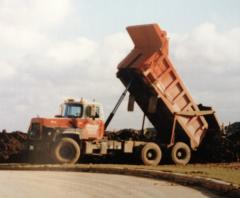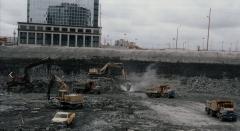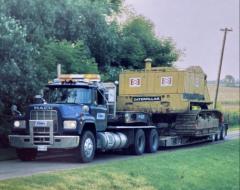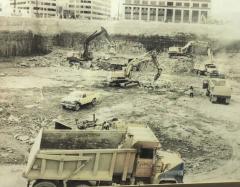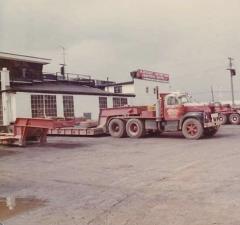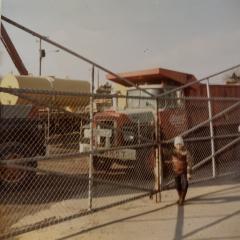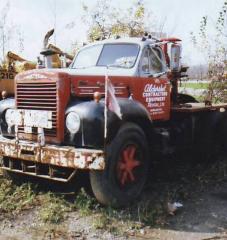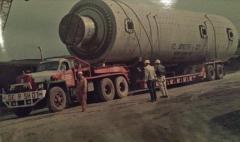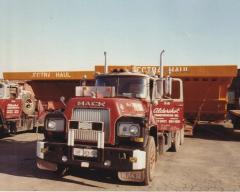-
Posts
6,796 -
Joined
-
Last visited
-
Days Won
85
Content Type
Profiles
Forums
Gallery
Events
Blogs
BMT Wiki
Collections
Store
Everything posted by mrsmackpaul
-
Aunt Jemima isnt showing up, if I squint really hard I can almost, nah I'm dreaming 😁 Paul
-
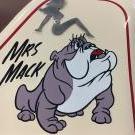
New here! B60T project
mrsmackpaul replied to SkippyMack's topic in Antique and Classic Mack Trucks General Discussion
Good for you, someone has to keep things moving Dunno about this headliner business as I have never even tried to do one Paul -
Well all the motor end is back together Time to look at the range change on the box Pulled the seats and rolled the floor mat up ready to pull the floor out Thought I might as well change that air filter and see if it improves the shifting, had no clunk to it no more, as in it didn't go clunk when sliding it into gear I had the new filter on hand so it had to be changed anyway It was black on the inside to look at so I decided to cut it open Yuck, I did expect it to be pretty bad as the compressor was pumping oil fairly well So thru some air in Mrs Mack and worked the high low spliter and it improved quite a bit after a few hundred shifts, I figured I have most of stuff out on the ground to pull the top off the transmission I might as well do it now just to 100% sure the bolt hasnt come loose Turns out the bolts were tight and all was ok I know there will be some colourful language used getting it back together, this isnt my first rodeo I have done this on the side of the road once and fish the bolt out of the box with a magnet So the lid will go back on and put it all back together Changed one of the relay valves for the back end, will change the other It had plenty of oil in it as well All this oil is a concern as it is thru the air system and I probably should of changed the compressor a long time ago So I guess I will slowly change valves and maxi chambers im the near future
-
Considering that everything was pretty much built for a LHD the conversion covers it up completely, when I fixed the cab and unbolted all the brackets etc off the firewall all the holes for LHD are there but things are so well placed you would never know I know a fella that worked for Mack Australia back when R models were still coming off the production line and has to me they had templates made to place everything just right to achieve this Occasionally we come across this problem were as good as things were done there is just a mess to work around, however it's soon forgotten once everything is fitted back together again Paul
-
Well I realize this all a bit hum drum boring type of stuff but with not a huge amount going on on the forum I guess I best shiw everyone how not to do it 🤔 So as usual my day never goes to plan, I do question why I even bother with plans 😏 So I woke to find a parcel waiting at the gate this morning, it was my valves for the back end Was having breaky and the phone rings, my compressor had turned up and was also waiting for me So I figure its time to fit the compressor and all the other stuff that hangs off it and surrounds it So I first have to fit couplings and remove couplings off the old one I dunno how compressors are fitted in other parts of the world but we have the added bonus of steering shafts amd treadle valves and clutches and other stuff that makes oh so much roomier So after a few attempts at trying lift and fit bolts and dropping the compressor and going crook at the world I decide I need a plan 'B' So I make a hook, strap or lifting hook or what ever we call it And bolt it to the top of the compressor Chuck a ratchet strap up and over the supports for the radiator and hoist the compressor up and amazingly it slides straight in After that cluster of a job it took the rest of the day to fit all the rest of the stuff around the compressor So the powet steering is all hooked up along with the water or coolant So the job is nearing end, I'm bit frustrated, annoyed at myself as everything is locked down with Covid crap and I have had to make gaskets, normally this isnt a drama for me and would just make them but I'm all out of gasket material and can't just toddle off down the street but we aren't allowed to do that at the moment So for the first time in years I have gone back to a cardboard box Im frustrated as I didn't get better organized Not to worry, hopefully in a few days it will be sorted and I can get the proper gaskets Paul
-

Split Rims
mrsmackpaul replied to h67st's topic in Antique and Classic Mack Trucks General Discussion
I have read about a rim thatIm guessing was this style, seem to have recalled it had some photos with the story Had a special jacking doodah that pulled the inner in, maybe it's that style of rim Sure is different than anything I have ever seen Paul -

Parts availability for older trucks?
mrsmackpaul replied to Offroadingrlife's topic in Modern Mack Truck General Discussion
I'm a bit late to the conversation, so dayton or spiders as we call them are quick and simple to change and are stronger, at least that is what is found in Australia I wouldn't let it faze me at all, to me it would be a bonus especially if I was starting out as I dont need any special tools to change a flat tyre Reading back thru the posts here it appears your pretty fixated on how many miles something has done While I understand your reasoning I think it's a bit flawed If you find a truck 25 years old with only a few hundred thousand miles on it to me it would have been around the clock, so it most likely has 1.3 million miles This isnt and shouldn't be a deal breaker, almost every truck of this age will have a huge amount of miles on it and had a lot of work done to it, that's just normal for a working truck In fact I think if it hadn't had a lot of work done to it that it would be of more concern I always look for something that isn't modified in a big way as this makes it so much easier to get parts, especially these days when you stroll on up to the parts counter and they ask you for the vin number first The modifications I think of are drive line etc as in different motors, transmission and assend Good luck and keep the dream alive Paul -
Well Swishman I had a go at spanner building and I reckon the results were fine and worked ok Started of with some old hoop iron or flat bar or what ever you want call it Cut some grooves in it, not all the way thru and then shaped, bent and welded it into a hexagon to match the nuts Then welded a short piece of 2 1/2 inch pipe to that Then welded some plate to the end and drilled 3/4 holes thru each side and the end The end one I filed out square to take a 3/4 drive ratchet I also welded a piece of re bar around the nut end to give it some extra strength and ground the end smooth It took a fare while to die grond and file and generally stuff around to get this to be a neat fit on the nut It was after lunch when done So cleaned up the hubs, bearings and brake drums Fitted new seals and refitted the front wheels So I'm still waiting on the compressor to turn up and a couple of air valves for the ass end While I'm waiting I'll lift the lid on the range change bit of the box and check everthing is ok there This involves pulling the seats out and lifting the floor mats I have a hole in the rear of the floor from a previous operation that facilitates this job Lot's of big and important sounding words there that almost make me sound smart 😁 Paul
-

F6034240-3123-437F-9071-488C617FBB05.jpeg
mrsmackpaul commented on Jaws612's gallery image in BMT Member's Gallery - Click here to view our member's albums!
-
Sorry Im of no help, it's a long way to modern for me Paul
-
I'll have a go today at spanner building Swishman
-
Achieved some more, the Tip Turbine is all back together Never got a answer on the grease so just used wheel bearing grease So it's all back together and fitted back to the truck Then proceeded to fix the stub axle nuts that hold the bearings on after some clowns had taken to them with a hammer and chisel, no doubt Les and Vern So welded them and ground them back with a flap wheel Now I need to find a socket to fit They came up pretty good I thought Paul
-
Not thinking you were a smart ass at all, we really have no idea about how others live and the conditions they live and work in, how could we as we aren't living in their world Well I guess for your cold we get heat in summer, well over a 100 degrees in the old money for weeks at a time Winters can be a tad uncomfortable as well, for me anyway, down 25 degrees f, - 4 degrees Celsius For you blokes that might be a nice day but we dont really dress for it or have clothes suitable for that weather because by 9 or 10 in the morning it generally is a nice day The morning shown the air start valves were frozen shut and we weren't going anywhere quick Once again not cold by a lot of the world's standard but pretty cold for me brrrrr So building of the shed is going to take me a while as I'll do it all myself as that's the way I was bought up Gunna mix my own concrete, well over a 100 cubic meters, make my own frames and trusses, the lot Paul
-
No problems finding brake parts at this stage, almost every R model ever sold in Australia had spokes or spiders so there is still the demand I have heard of some front brake drums are getting harder to get Yes the open air work shop isnt ideal, the oil absorbent floor might sound good on paper in real life it's pretty ordinary We are building a shed/work shop on the block but I can't do everything at once and it took forever and cost a fortune just to get plans approved So am hoping to get started on it shortly, 120 x 80 x 15 feet door opening height Paul
-
Surpose I best add a bit to the story Mrs Mack is up blocks, literally and doing some maintenance on her So a quick list of what I'm doing New brakes and seals on the front axle New compressor High and low range didn't go into high range properly out if the blue the other day, I have had the bolt on the selector fork drop out before So I'll lift the lid and if this has happened I will refit the bolt and drill a hole thru the head and thread wire thru it and onto the shaft I'm hoping it is just the filter as the compressor has been pump crappy oily air for some time now, it's always good to make sure that everything else is ok The tip turbine hasnt been working for some time, as in I can hear it isnt going a lot of the time so I'll put fresh bearings in it New cans on the front axle And a couple of new valves om the ass end that leak air sometimes All in all there's nothing major, rather a lot of little stuff that has built up Oh and I'll also replace the power steering hoses as they are the only real leak the truck has So have fitted new brake shoes and cans and hoses to the front axle The shoes are different to the ones that came off, they are however from Mack and do fit better New S cam bushes Waiting on new oil seals for the front hubs before slipping it back together So have gone as far as I can go there, waiting on the new compressor to arrive Replaced all the power steering hoses So I pulled the tip turbine off and apart and have ordered the new bearings Been a thrust bearing I never took enough notice when I pulled them off which way the bearings went, I'm guessing open side facing each other, will look in the book Not a lot else to report, mainly waiting on parts to arrive Filter kit from Mack is meant to be in today as is a injector line for number one Will at least get the front end back together before shifting further back Paul
-

New here! B60T project
mrsmackpaul replied to SkippyMack's topic in Antique and Classic Mack Trucks General Discussion
Acid dip it maybe ? thats the air cleaner Im talking about Very hard to give a opinion with out seeing it Paul -
I am putting new bearings in a tip turbine Apparently there'sa special grease, or maybe a specified grease Does anyone know what this is ? Thanks in advance for any help Paul
-
Well purchased a new to me R model and a couple of trailers, site unseen, on line a week or more ago and they finally arrived I'm more than happy with them A British Mack at that Needs a new bonnet latch, and one trailer needs a few tyres So to be clear this Mack is made in the U.K., it's Dinki to brand I bought out of the U.S., it was on a Facebook site to the link on ebay Less than 10 bucks, what a bargain I reckon Bonnet (hood) tilts, quick release turn table (fifth wheel) and legs for the trailers First truck I habe owned with 10 stud aluminium budd type rims Paul
-

9E884832-6386-4A93-A6AC-70C4D60EF3C2.jpeg
mrsmackpaul commented on Jaws612's gallery image in BMT Member's Gallery - Click here to view our member's albums!
-
Yep gotta agree there, even when raised with basic manners and respect it doesn't guarantee a good outcome, it does however I feel greatly increase the chances Paul
-

Jaws612 Ontario Macks
mrsmackpaul commented on Jaws612's gallery album in BMT Member's Gallery - Click here to view our member's albums!
-
Well it looks like it has finally happened The new Anthem is Australianized for Australia Gone are the poxy mirrors, a heap of the plastic farings and crap along the sides and has been replaced by square fuel tanks No doubt a whole lot more like the steering wheel on the correct side Trident has been up graded and it appears to be available with the stand up sleeper Anyway read about it bellow Are you interested in seeing what all the fuss is about?? Do you want to come see the all new styled Mack range including the Mack Anthem and updated Mack Trident and Superliner? Do you want to take one for a test drive? They will be loaded and ready to show you how they preform. These new range of Mack’s will be at VCV Newcastle on Thursday the 4th of February from midday til Friday midday. Want to know more? Shoot the VCV page a message and myself or Brandon will do their best to answer your questions. There will be a few reminder posts as we know you are all busy people. #mack #macktrucks #newmodels #anthem #trident #superliner Mack Trucks Australia Paul
-

Tony Champion's Collection
mrsmackpaul replied to Brocky's topic in Antique and Classic Mack Trucks General Discussion
Thinking just go and see them at the dealership and ask and I dare say it would be organized pretty quickly Paul
BigMackTrucks.com
BigMackTrucks.com is a support forum for antique, classic and modern Mack Trucks! The forum is owned and maintained by Watt's Truck Center, Inc. an independent, full service Mack dealer. The forums are not affiliated with Mack Trucks, Inc.
Our Vendors and Advertisers
Thank you for your support!





